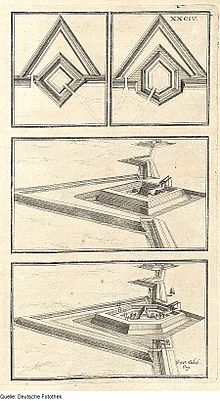Hill (fortress construction)

According to the terminology of German fortress construction, a hill is an independent fortification that is often used in the construction of temporary (non-permanent) field fortifications .
In colloquial language, however, permanent fortifications are often referred to as " entrenchments ", which in many places is due to the fact that initially only provisional fortifications were later expanded into permanent fortifications in times of war, see Landesfestung Ingolstadt (see also the section on transferring the term entrenchment ) .
To derive the word
The word “Schanze” is originally derived from brushwood bundles , as provisional fortifications were often built from entrenchments during sieges in the late Middle Ages . Later such jumps were very often built from earth walls. Therefore, in the 16th century, the word “schanzen” was generally applied to earthworks of all kinds. Military parlance still uses entrenchments for smaller earthworks, especially for the construction of trenches . From this linguistic usage, which has already been transferred, the expression entrench in the broader figurative sense also comes : B. "hide behind paragraphs".
The ski jump as a fortification

Example of a medieval city complex with city walls and towers, which Sweden added to entrenchments around 1640.
A ski jump is usually an independent fortification. To block a valley or a pass, however, a number of jumps can be built next to each other, which were often connected to one another by a low wall and ditch. In this case one speaks of an "entrenched line". If such a line completely encloses a room on all sides, then this is called an "entrenched camp" (such " entrenched camps " often used weaker armies in the 17th and 18th centuries to protect themselves against a stronger one). During sieges, “entrenched lines” often also served as contravallation or circumvallation lines .
After their floor plan, a distinction is open from closed redoubts . The closed ones are further divided into redoubts , which only have jutting angles, and star jumps with alternating jutting out and entering angles. In the case of open jumps , which can have the shape of a Flesche , Redans, half redoubt, lunette , hornwork or even more complex systems, the throat is open; d. H. the side where one's own army camped or where one's own fortress was located was unfortified.
Image gallery of semi-permanent systems
Some examples of semi-permanent facilities (i.e. plants that were initially built like field fortifications, but were maintained and partially expanded for a longer period of time):
Model of the Hetlinger Schanze around 1757 (actually a Danish fortress on the Elbe that was created from a provisional ski jump and has kept the name Schanze ).
The Mannheimer Rheinschanze , the city and the citadel Mannheim in the year 1620. The so-called Rheinschanze was the bridgehead of Mannheim on the left side of the river in the form of a horn factory (above in the picture where the city of Ludwigshafen is today).
Matthäus Merian: Illustration of the Swedish Schantz located on the Weysselstrom in Prussia . Anno 1626. During the war temporary work to block the Vistula estuary.
Transfer of the term Schanze
With the development of archeology in the 19th century, the term Schanze was also transferred to the remains of prehistoric ramparts (→ Viereckschanze , also called Keltenschanze ), although no distinction was / is made between fortifications and cultic-religious structures.
Web links
literature
- Schanze in Meyers Konversations-Lexikon 4th ed. 1888 ff., Vol. 14, p. 403
- Replica of a hexagonal redoubt on a scale of 1: 1 with a link to the construction diary





